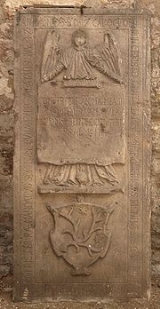
Friedrich Risner
Encyclopedia
Friedrich Risner was a German
mathematician from Hersfeld
http://upload.wikimedia.org/wikipedia/commons/e/e0/De_Merian_Hassiae_128.jpg, Hesse
. He was a student of Petrus Ramus
(1515-1572) and was the first chair of mathematics at Collège Royale de France
.
 He is known for his 1572 publication of "Opticae thesaurus: Alhazeni Arabis libri septem, nuncprimum editi; Eiusdem liber De Crepusculis et nubium ascensionibus, Item Vitellonis Thuringopoloni libri X", which was an edition of the works of Ibn al-Haitham
He is known for his 1572 publication of "Opticae thesaurus: Alhazeni Arabis libri septem, nuncprimum editi; Eiusdem liber De Crepusculis et nubium ascensionibus, Item Vitellonis Thuringopoloni libri X", which was an edition of the works of Ibn al-Haitham
and Erazmus Ciolek Witelo
, who were both early pioneers in the study of optics
. This publication was a major benefit to several famous mathematicians and scientists, that included Kepler, Huygens, and Descartes.
Risner was the first to propose the idea of a portable camera obscura
, which purportedly was to be used to help create artistic topographical drawings. His idea consisted of a lightweight wooden hut that had small holes fitted with lenses in each wall, and a cube of paper placed in the centre for drawing.
After St. Bartholomew's Day massacre
, Risner fled back to Hersfeld and died there eight years later. Risner was buried in Hersfeld Abbey
, where his gravestone is well preserved.
The Latin circumscription on the gravestone is: "Anno Domini 1580. 17. Cal. Octob. pie in Christo obiit clariss. vir Fridericus Risner insignis et praestantissimus Mathematicus qui hic terrae mandatus sonitum tubae expectat aetatis suae 47."
English translation of the inscription above is: "In year 1580 at 15th of September, died in Christ at the age of 47, the well famous Friedrich Risner, an outstanding, excellent mathematician, who passed to soil here, will expect the sound of trumpet."
Germans
The Germans are a Germanic ethnic group native to Central Europe. The English term Germans has referred to the German-speaking population of the Holy Roman Empire since the Late Middle Ages....
mathematician from Hersfeld
Bad Hersfeld
The festival and spa town of Bad Hersfeld is the district seat of Hersfeld-Rotenburg district in northeastern Hesse, Germany, roughly 50 km southeast of Kassel....
http://upload.wikimedia.org/wikipedia/commons/e/e0/De_Merian_Hassiae_128.jpg, Hesse
Hesse
Hesse or Hessia is both a cultural region of Germany and the name of an individual German state.* The cultural region of Hesse includes both the State of Hesse and the area known as Rhenish Hesse in the neighbouring Rhineland-Palatinate state...
. He was a student of Petrus Ramus
Petrus Ramus
Petrus Ramus was an influential French humanist, logician, and educational reformer. A Protestant convert, he was killed during the St. Bartholomew's Day Massacre.-Early life:...
(1515-1572) and was the first chair of mathematics at Collège Royale de France
Collège de France
The Collège de France is a higher education and research establishment located in Paris, France, in the 5th arrondissement, or Latin Quarter, across the street from the historical campus of La Sorbonne at the intersection of Rue Saint-Jacques and Rue des Écoles...
.

Ibn al-Haitham
' was a Muslim, scientist and polymath described in various sources as either Arabic or Persian...
and Erazmus Ciolek Witelo
Witelo
Witelo was a friar, theologian and scientist: a physicist, natural philosopher, mathematician. He is an important figure in the history of philosophy in Poland...
, who were both early pioneers in the study of optics
Optics
Optics is the branch of physics which involves the behavior and properties of light, including its interactions with matter and the construction of instruments that use or detect it. Optics usually describes the behavior of visible, ultraviolet, and infrared light...
. This publication was a major benefit to several famous mathematicians and scientists, that included Kepler, Huygens, and Descartes.
Risner was the first to propose the idea of a portable camera obscura
Camera obscura
The camera obscura is an optical device that projects an image of its surroundings on a screen. It is used in drawing and for entertainment, and was one of the inventions that led to photography. The device consists of a box or room with a hole in one side...
, which purportedly was to be used to help create artistic topographical drawings. His idea consisted of a lightweight wooden hut that had small holes fitted with lenses in each wall, and a cube of paper placed in the centre for drawing.
After St. Bartholomew's Day massacre
St. Bartholomew's Day massacre
The St. Bartholomew's Day massacre in 1572 was a targeted group of assassinations, followed by a wave of Roman Catholic mob violence, both directed against the Huguenots , during the French Wars of Religion...
, Risner fled back to Hersfeld and died there eight years later. Risner was buried in Hersfeld Abbey
Hersfeld Abbey
Hersfeld Abbey was an important Benedictine imperial abbey in the town of Bad Hersfeld in Hesse , Germany, at the confluence of the rivers Geisa, Haune and Fulda.-History:...
, where his gravestone is well preserved.
The Latin circumscription on the gravestone is: "Anno Domini 1580. 17. Cal. Octob. pie in Christo obiit clariss. vir Fridericus Risner insignis et praestantissimus Mathematicus qui hic terrae mandatus sonitum tubae expectat aetatis suae 47."
English translation of the inscription above is: "In year 1580 at 15th of September, died in Christ at the age of 47, the well famous Friedrich Risner, an outstanding, excellent mathematician, who passed to soil here, will expect the sound of trumpet."

